
Concept explainers
(A)
To express the dimensions in inches upto 3 decimal places.
Answer to Problem 34A
The dimension
Explanation of Solution
Given Information:
Given,the part shown in figure is to be made in a machine shop using decimal-inch machinery and tools. All dimensions are in millimeters.
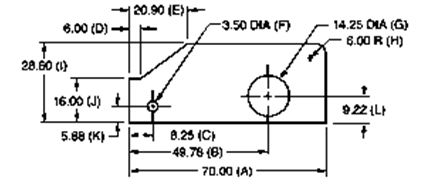
Calculation:
To express a unit in one system as an equivalent unit in the other system, either use unity fractions or multiply the given measurements by the appropriate conversion factor in the metric-Customary Linear Equivalent Table
As we know that,
Converting
Hence, the dimension
(B)
To express the dimensions in inches up to 3 decimal places.
Answer to Problem 34A
The dimension
Explanation of Solution
Given Information:
Given, the part shown in figure is to be made in a machine shop using decimal-inch machinery and tools. All dimensions are in millimeters.
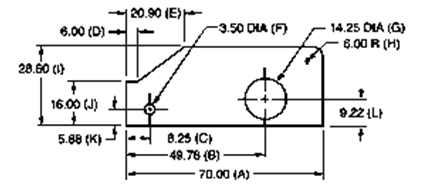
Calculation:
To express a unit in one system as an equivalent unit in the other system, either use unity fractions or multiply the given measurements by the appropriate conversion factor in the metric-Customary Linear Equivalent Table
As we know that,
Converting
Hence, the dimension
(C)
To express the dimensions in inches up to 3 decimal places.
Answer to Problem 34A
The dimension
Explanation of Solution
Given Information:
Given, the part shown in figure is to be made in a machine shop using decimal-inch machinery and tools. All dimensions are in millimeters.
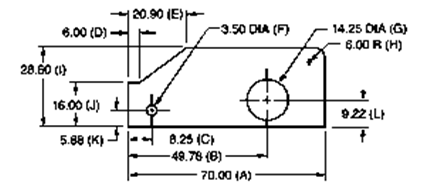
Calculation:
To express a unit in one system as an equivalent unit in the other system, either use unity fractions or multiply the given measurements by the appropriate conversion factor in the metric-Customary Linear Equivalent Table
As we know that,
Converting
Hence, the dimension
(D)
To express the dimensions in inches up to 3 decimal places.
Answer to Problem 34A
The dimension
Explanation of Solution
Given Information:
Given, the part shown in figure is to be made in a machine shop using decimal-inch machinery and tools. All dimensions are in millimeters.
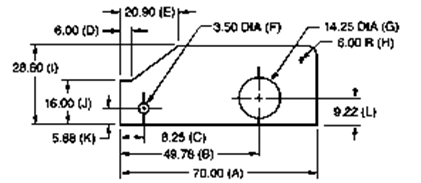
Calculation:
To express a unit in one system as an equivalent unit in the other system, either use unity fractions or multiply the given measurements by the appropriate conversion factor in the metric-Customary Linear Equivalent Table
As we know that,
Converting
Hence, the dimension
(E)
To express the dimensions in inches up to 3 decimal places.
Answer to Problem 34A
The dimension
Explanation of Solution
Given Information:
Given, the part shown in figure is to be made in a machine shop using decimal-inch machinery and tools. All dimensions are in millimeters.
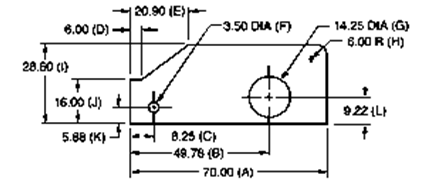
Calculation:
To express a unit in one system as an equivalent unit in the other system, either use unity fractions or multiply the given measurements by the appropriate conversion factor in the metric-Customary Linear Equivalent Table
As we know that,
Converting
Hence, the dimension
(F)
To express the dimensions in inches up to 3 decimal places.
Answer to Problem 34A
The dimension
Explanation of Solution
Given Information:
Given, the part shown in figure is to be made in a machine shop using decimal-inch machinery and tools. All dimensions are in millimeters.
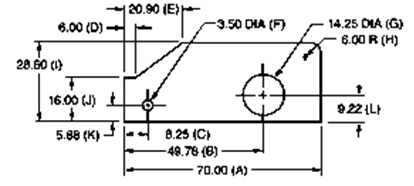
Calculation:
To express a unit in one system as an equivalent unit in the other system, either use unity fractions or multiply the given measurements by the appropriate conversion factor in the metric-Customary Linear Equivalent Table
As we know that,
Converting
Hence, the dimension
(G)
To express the dimensions in inches up to 3 decimal places.
Answer to Problem 34A
The dimension
Explanation of Solution
Given Information:
Given, the part shown in figure is to be made in a machine shop using decimal-inch machinery and tools. All dimensions are in millimeters.
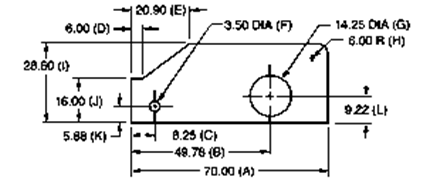
Calculation:
To express a unit in one system as an equivalent unit in the other system, either use unity fractions or multiply the given measurements by the appropriate conversion factor in the metric-Customary Linear Equivalent Table
As we know that,
Converting
Hence, the dimension
(H)
To express the dimensions in inches up to 3 decimal places.
Answer to Problem 34A
The dimension
Explanation of Solution
Given Information:
Given, the part shown in figure is to be made in a machine shop using decimal-inch machinery and tools. All dimensions are in millimeters.
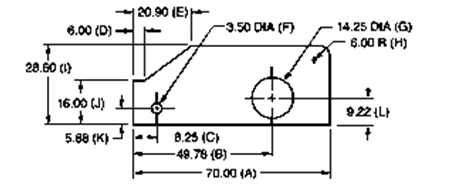
Calculation:
To express a unit in one system as an equivalent unit in the other system, either use unity fractions or multiply the given measurements by the appropriate conversion factor in the metric-Customary Linear Equivalent Table
As we know that,
Converting
Hence, the dimension
(I)
To express the dimensions in inches up to 3 decimal places.
Answer to Problem 34A
The dimension
Explanation of Solution
Given Information:
Given, the part shown in figure is to be made in a machine shop using decimal-inch machinery and tools. All dimensions are in millimeters.
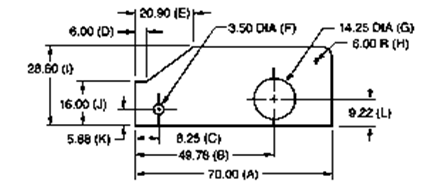
Calculation:
To express a unit in one system as an equivalent unit in the other system, either use unity fractions or multiply the given measurements by the appropriate conversion factor in the metric-Customary Linear Equivalent Table
As we know that,
Converting
Hence, the dimension
(J)
To express the dimensions in inches up to 3 decimal places.
Answer to Problem 34A
The dimension
Explanation of Solution
Given Information:
Given, the part shown in figure is to be made in a machine shop using decimal-inch machinery and tools. All dimensions are in millimeters.
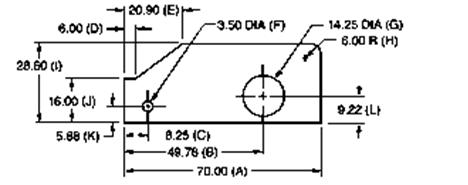
Calculation:
To express a unit in one system as an equivalent unit in the other system, either use unity fractions or multiply the given measurements by the appropriate conversion factor in the metric-Customary Linear Equivalent Table
As we know that,
Converting
Hence, the dimension
(K)
To express the dimensions in inches up to 3 decimal places.
Answer to Problem 34A
The dimension
Explanation of Solution
Given Information:
Given, the part shown in figure is to be made in a machine shop using decimal-inch machinery and tools. All dimensions are in millimeters.
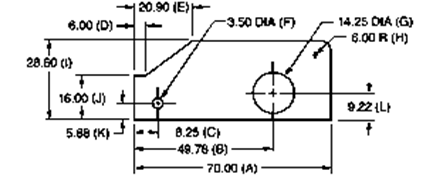
Calculation:
To express a unit in one system as an equivalent unit in the other system, either use unity fractions or multiply the given measurements by the appropriate conversion factor in the metric-Customary Linear Equivalent Table
As we know that,
Converting
Hence, the dimension
(L)
To express the dimensions in inches up to 3 decimal places.
Answer to Problem 34A
The dimension
Explanation of Solution
Given Information:
Given, the part shown in figure is to be made in a machine shop using decimal-inch machinery and tools. All dimensions are in millimeters.
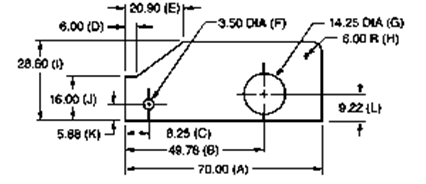
Calculation:
To express a unit in one system as an equivalent unit in the other system, either use unity fractions or multiply the given measurements by the appropriate conversion factor in the metric-Customary Linear Equivalent Table
As we know that,
Converting
Hence, the dimension
Want to see more full solutions like this?
Chapter 27 Solutions
EBK MATHEMATICS FOR MACHINE TECHNOLOGY
- The Martin-Beck Company operates a plant in St. Louis with an annual capacity of 30,000 units. Product is shipped to regional distribution centers located in Boston, Atlanta, and Houston. Because of an anticipated increase in demand, Martin-Beck plans to increase capacity by constructing a new plant in one or more of the following cities: Detroit, Toledo, Denver, or Kansas. The following is a linear program used to determine which cities Martin-Beck should construct a plant in. Let y₁ = 1 if a plant is constructed in Detroit; 0 if not y₂ = 1 if a plant is constructed in Toledo; 0 if not y₂ = 1 if a plant is constructed in Denver; 0 if not y = 1 if a plant is constructed in Kansas City; 0 if not. The variables representing the amount shipped from each plant site to each distribution center are defined just as for a transportation problem. *,, = the units shipped in thousands from plant i to distribution center j i = 1 (Detroit), 2 (Toledo), 3 (Denver), 4 (Kansas City), 5 (St.Louis) and…arrow_forwardConsider the following mixed-integer linear program. Max 3x1 + 4x2 s.t. 4x1 + 7x2 ≤ 28 8x1 + 5x2 ≤ 40 x1, x2 ≥ and x1 integer (a) Graph the constraints for this problem. Indicate on your graph all feasible mixed-integer solutions. On the coordinate plane the horizontal axis is labeled x1 and the vertical axis is labeled x2. A region bounded by a series of connected line segments, and several horizontal lines are on the graph. The series of line segments connect the approximate points (0, 4), (3.889, 1.778), and (5, 0). The region is above the horizontal axis, to the right of the vertical axis, and below the line segments. At each integer value between 0 and 4 on the vertical axis, a horizontal line extends out from the vertical axis to the series of connect line segments. On the coordinate plane the horizontal axis is labeled x1 and the vertical axis is labeled x2. A region bounded by a series of connected line segments, and several…arrow_forwardConsider the nonlinear optimization model stated below. Min s.t. 2x²-18x + 2XY + y² - 14Y + 53 x + 4Y ≤ 8 (a) Find the minimum solution to this problem. |at (X, Y) = (b) If the right-hand side of the constraint is increased from 8 to 9, how much do you expect the objective function to change? Based on the dual value on the constraint X + 4Y ≤ 8, we expect the optimal objective function value to decrease by (c) Resolve the problem with a new right-hand side of the constraint of 9. How does the actual change compare with your estimate? If we resolve the problem with a new right-hand-side of 9 the new optimal objective function value is| , so the actual change is a decrease of rather than what we expected in part (b).arrow_forward
- Statement:If 2 | a and 3| a, then 6 a. So find three integers, and at least one integer should be negative. For each of your examples, determine if the statement is true or false.arrow_forwardStatement: If 4 | a and 6 | a, then 24 | a. So find three integers, and at least one integer should be negative. For each of your examples, determine if the statement is true or false.arrow_forward2) dassify each critical point of the given plane autovers system x'=x-2x²-2xy y' = 4y-Sy³-7xyarrow_forward
- 24.2. Show that, for any constant zo Є C, (a). e* = e²o Σ j=0 (2 - 20); j! |z|arrow_forward25.4. (a). Show that when 0 < || < 4, 1 1 8 zn 4z - z2 4z +Σ 4n+2* (b). Show that, when 0 < |z1|<2, n=() 2 1 8 (z - 1)(z - 3) - 3 2(z - 1) 3 Σ (2-1)" 27+2 n=0 (c). Show that, when 2<|z|< ∞, 1 z4+4z2 -*()*. n=0arrow_forward. Expand sinh z in Taylor's series at zo = πi, and show that lim sinh: καπί κ - п - - 1.arrow_forwardarrow_back_iosSEE MORE QUESTIONSarrow_forward_ios
 Mathematics For Machine TechnologyAdvanced MathISBN:9781337798310Author:Peterson, John.Publisher:Cengage Learning,
Mathematics For Machine TechnologyAdvanced MathISBN:9781337798310Author:Peterson, John.Publisher:Cengage Learning, Algebra: Structure And Method, Book 1AlgebraISBN:9780395977224Author:Richard G. Brown, Mary P. Dolciani, Robert H. Sorgenfrey, William L. ColePublisher:McDougal Littell
Algebra: Structure And Method, Book 1AlgebraISBN:9780395977224Author:Richard G. Brown, Mary P. Dolciani, Robert H. Sorgenfrey, William L. ColePublisher:McDougal Littell Glencoe Algebra 1, Student Edition, 9780079039897...AlgebraISBN:9780079039897Author:CarterPublisher:McGraw Hill
Glencoe Algebra 1, Student Edition, 9780079039897...AlgebraISBN:9780079039897Author:CarterPublisher:McGraw Hill Elementary Geometry For College Students, 7eGeometryISBN:9781337614085Author:Alexander, Daniel C.; Koeberlein, Geralyn M.Publisher:Cengage,
Elementary Geometry For College Students, 7eGeometryISBN:9781337614085Author:Alexander, Daniel C.; Koeberlein, Geralyn M.Publisher:Cengage,




